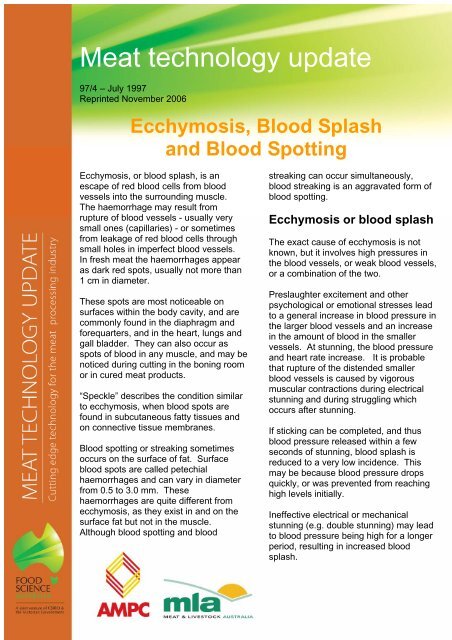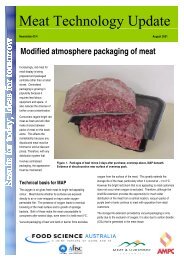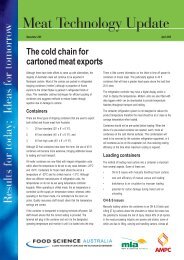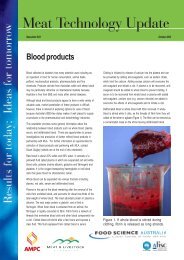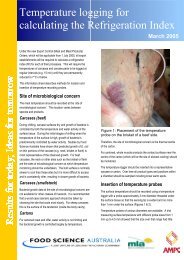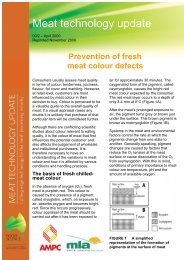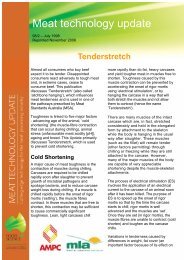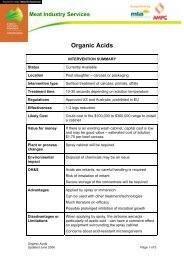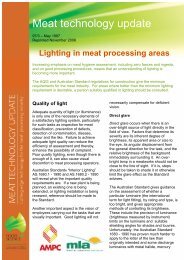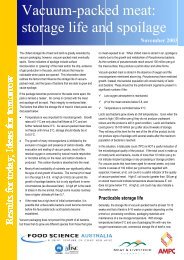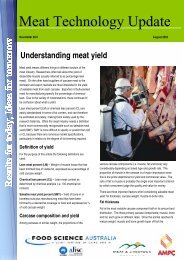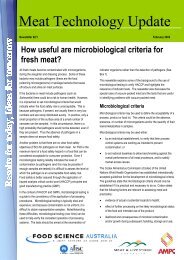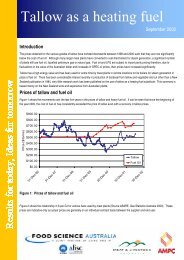Ecchymosis, Blood Splash and Blood Spotting - Meat Industry ...
Ecchymosis, Blood Splash and Blood Spotting - Meat Industry ...
Ecchymosis, Blood Splash and Blood Spotting - Meat Industry ...
You also want an ePaper? Increase the reach of your titles
YUMPU automatically turns print PDFs into web optimized ePapers that Google loves.
<strong>Meat</strong> technology update97/4 – July 1997Reprinted November 2006<strong>Ecchymosis</strong>, <strong>Blood</strong> <strong>Splash</strong><strong>and</strong> <strong>Blood</strong> <strong>Spotting</strong><strong>Ecchymosis</strong>, or blood splash, is anescape of red blood cells from bloodvessels into the surrounding muscle.The haemorrhage may result fromrupture of blood vessels - usually verysmall ones (capillaries) - or sometimesfrom leakage of red blood cells throughsmall holes in imperfect blood vessels.In fresh meat the haemorrhages appearas dark red spots, usually not more than1 cm in diameter.These spots are most noticeable onsurfaces within the body cavity, <strong>and</strong> arecommonly found in the diaphragm <strong>and</strong>forequarters, <strong>and</strong> in the heart, lungs <strong>and</strong>gall bladder. They can also occur asspots of blood in any muscle, <strong>and</strong> may benoticed during cutting in the boning roomor in cured meat products.“Speckle” describes the condition similarto ecchymosis, when blood spots arefound in subcutaneous fatty tissues <strong>and</strong>on connective tissue membranes.<strong>Blood</strong> spotting or streaking sometimesoccurs on the surface of fat. Surfaceblood spots are called petechialhaemorrhages <strong>and</strong> can vary in diameterfrom 0.5 to 3.0 mm. Thesehaemorrhages are quite different fromecchymosis, as they exist in <strong>and</strong> on thesurface fat but not in the muscle.Although blood spotting <strong>and</strong> bloodstreaking can occur simultaneously,blood streaking is an aggravated form ofblood spotting.<strong>Ecchymosis</strong> or blood splashThe exact cause of ecchymosis is notknown, but it involves high pressures inthe blood vessels, or weak blood vessels,or a combination of the two.Preslaughter excitement <strong>and</strong> otherpsychological or emotional stresses leadto a general increase in blood pressure inthe larger blood vessels <strong>and</strong> an increasein the amount of blood in the smallervessels. At stunning, the blood pressure<strong>and</strong> heart rate increase. It is probablethat rupture of the distended smallerblood vessels is caused by vigorousmuscular contractions during electricalstunning <strong>and</strong> during struggling whichoccurs after stunning.If sticking can be completed, <strong>and</strong> thusblood pressure released within a fewseconds of stunning, blood splash isreduced to a very low incidence. Thismay be because blood pressure dropsquickly, or was prevented from reachinghigh levels initially.Ineffective electrical or mechanicalstunning (e.g. double stunning) may leadto blood pressure being high for a longerperiod, resulting in increased bloodsplash.
Some diseases may weaken the bloodvessel walls <strong>and</strong> result in an increasedoccurrence of haemorrhages.(c)Bleeding should be carried outas soon as possible afterstunning.Climatic conditions appear to influence theincidence of the disorder. It is mostprevalent in hot weather.Subcutaneous ‘speckle’ in mutton <strong>and</strong> lamb -the condition similar to ecchymosis - appearsto result from shearing of blood vesselsduring the stun. Speckle is aggravated bylong stunning times when electric stunning isused, <strong>and</strong> also by tight restrainingconveyors. If it looks like a mild wool-pullbruise along the side of the carcase, this islikely to be due to the wool being pulledbetween the sheep’s body <strong>and</strong> the restraineras the animal goes into a spasm.Feed may be a contributory factor to theoccurrence of ecchymosis. Anticoagulant(anti-bloodclotting) substances in some typesof pasture may predispose animals to bloodsplash.2. Electrical stunning of smallstockThe animal must become rigidimmediately the stunning electrodesare applied. If it escapes from theelectrodes or the initial contact isinsufficient to produce rigidity, theanimal becomes distressed <strong>and</strong>struggles which, in turn, makes it moredifficult to apply the electrodes. If aparticular electrical stunning methodpersistently leads to interruptedstunning, it can be improved in thefollowing ways. It may be possible toimprove the presentation of the animalto the slaughterman, so that theelectrodes are then easier to placeaccurately <strong>and</strong> firmly. It may also bepossible to improve the equipment toreduce the electrical resistance of theanimal <strong>and</strong> the electrodes.Prevention1. Stunning cattle(a)(b)Animals should not be excitedor stressed before stunning.Stunning must be done quickly<strong>and</strong> effectively. With bothpenetrating bolt stunners <strong>and</strong>‘mushroom head’ stunners, theplacement of the bolt or head atthe correct position on theanimal’s skull is very important<strong>and</strong> this requires skilledoperators <strong>and</strong> well designedknocking boxes or restrainers.The use of the appropriatecartridge or the correct airpressure (for air-poweredstunners) is essential, as isregular maintenance of thestunning equipment. Avoid theneed for double stunning.(a)(b)(c)Minimise stress <strong>and</strong>excitement.Animals should not be allowedto remain in a restraining racefor long periods, <strong>and</strong> should bestunned at an even rate.The incidence <strong>and</strong> severity ofecchymosis can be reduced byusing low stunning currents <strong>and</strong>short stunning times. Thelowest voltage found to givesatisfactory stunning should beused, particularly for lambs <strong>and</strong>other young animals. Thevoltage <strong>and</strong> the time ofapplication needed for younganimals is less than thatneeded for older animals.Voltage <strong>and</strong> time settings arealso affected by factors such asthe length of the fleece, amountof moisture on the skin or hide2
(d)(e)in contact with the electrodes,<strong>and</strong> the type of machine in use.Correct electrode placement<strong>and</strong> establishment of the rightcurrent flow (amperage)through the brain are theimportant factors.Regular maintenance isnecessary. The electrodesshould be kept clean <strong>and</strong>, withprobe types, the pointssharpened regularly.The animals should be bled assoon as possible after stunning.The interval between stunning<strong>and</strong> commencement ofbleeding ideally should notexceed 10 seconds.If ecchymosis occurs, it is useful to recordthe number of animals affected in mobs ofknown history over a period of time. In thisway it is sometimes possible to identifyreasons <strong>and</strong> remedy the situation. Ifecchymosis occurs more often in animalsfrom certain farms <strong>and</strong>/or areas, this mayindicate a pasture <strong>and</strong>/or stress problem.<strong>Blood</strong> spotting or bloodstreakingDuring dressing on inverted dressing lines,surface blood spots <strong>and</strong> streaks can occuron the hindquarters of ovine carcases <strong>and</strong>financially impact the industry. However,these two blemishes can be reduced byensuring efficient bleeding <strong>and</strong> usingadequate lead-up work before mechanicalpelt pulling commences.Whilst it is possible to reduce the incidenceof blood spotting <strong>and</strong> streaking, it isunrealistic to expect to avoid it completely onall carcases processed on an inverteddressing line.Observations in trials established todetermine the causes of blood spotting <strong>and</strong>possible remedial actions indicated thatspotting was the most frequent form of thedefect when the selvage was left largely or3completely intact throughout the dressingprocess.When the selvage is damaged to anysignificant extent during dressing, instead ofsome of the superficial blood vessels simplybeing ruptured beneath the selvage surface,the blood vessels are severed altogether <strong>and</strong>blood may run from the open ends to formstreaks.As the pelt is pulled from the carcase, a b<strong>and</strong>of pressure bears on the tissues adjacent tothe line of separation. In inverted dressingsystems, as this pressure b<strong>and</strong> moves overthe loins <strong>and</strong> hindquarters of the carcase, itpushes blood through the veins near thecarcase surface. This pressure eventuallyruptures some of these vessels (as the peltis separated from the carcase), <strong>and</strong> bloodinvades the surrounding tissue or leaksthrough broken veins onto the surface of thecarcase.Reducing blood spotting or streakingEfficient bleeding is not the sole answer toeliminating blood spotting <strong>and</strong> bloodstreaking. On the other h<strong>and</strong>, the severity ofblood spotting can be reduced by efficientbleeding. To maximise efficient bleeding:• The vena cava must be fully severedwith a thoracic stick.• As much time as possible should beallowed for bleeding prior to invertingthe carcase.• Carcases should be hung vertically foras long as possible before putting themon the spreaders. When on thespreaders, the carcase head <strong>and</strong>shoulders should be positioned belowthe back <strong>and</strong> the hind legs to provide ascomplete <strong>and</strong> rapid bleeding aspossible, <strong>and</strong> to minimisepooling of blood in the tissues near thesurface of the back.• The time during which the carcase is inthe inverted position prior to peltingshould be minimised.The incidence <strong>and</strong> severity of blood spotting
can be reduced - but not eliminated -by following slash cut sticking(whether this is done as ritual Halal orconventional slaughter) as rapidly aspossible with a full thoracic stick. Thethoracic stick should be deep <strong>and</strong> thevena cava should be severed close tothe heart. However, this could requireextra labour <strong>and</strong> therefore the othermeasures should be adopted first.The severity of blood spotting isdirectly related to the quality <strong>and</strong>extent of pre-pelting work-up.Accurate clearing <strong>and</strong> punching of thelateral surfaces of the chump <strong>and</strong> legcan reduce the problem. In particular,good clearing <strong>and</strong> positive separationof the pelt from the selvage lessensblood spotting. A good st<strong>and</strong>ard ofpre-pelting work-up also improvescarcase presentation.Age of lambs <strong>and</strong> sheep is anotherfactor influencing the incidence ofblood spotting <strong>and</strong> streaking. Thestrength of adhesion of the pelt to theouter fell appears to rise markedlywith animal age, thereby requiringadditional force to remove the pelt,<strong>and</strong> this appears to be closely relatedto the occurrence of blood spotting inolder sheep.the carcase surface when the pelt ispulled <strong>and</strong> blood spotting will occur.Whilst the mechanical pelt puller c<strong>and</strong>o most of the physically hard workassociated with actual pelt removal,adequate pre-pelt-pulling work-up is aprerequisite.Transporting, animal h<strong>and</strong>ling,humidity <strong>and</strong> temperature also appearto affect blood spotting. It has beensuggested that blood diverted to theskin (as in hot weather) leads togreater engorgement of the vascularsystem over the loin <strong>and</strong> chump areasduring inverted dressing. When bloodvessels are engorged, they can burst<strong>and</strong> cause blood spotting or streaking.In most situations, procedures can bedeveloped <strong>and</strong> implemented to reduceblood spotting <strong>and</strong> streaking.As a repair mechanism only, a largeproportion of surface blood spottingcan be removed with suitablemechanical carcase washing regimes.Wash jets should be angled about 45°below the horizontal. However, thiswill directly increase both the quantityof water used <strong>and</strong> effluent producedby the plant.Manning of the chain must beconsistent with achieving gooddressing. If the work-up is incomplete,excessive pressure will be applied toContact us for additional information<strong>Meat</strong> <strong>Industry</strong> Services is supported by the Australian <strong>Meat</strong> Processor Corporation (AMPC) <strong>and</strong> <strong>Meat</strong> & Livestock Australia (MLA).Brisbane: Sydney: Adelaide:Food Science Australia Bill Spooncer Chris SentancePO Box 3312 PO Box 181 PO Box 178Tingalpa DC QLD 4173 KURMOND NSW 2757 FLAGSTAFF HILL SA 5159Ian Eustace Neil McPhail Alison SmallT +61 7 3214 2117 T +61 7 3214 211 T +61 7 3214 2109 T +61 2 4567 7952 T +61 8 370 7466F +61 7 3214 2103 F +61 7 3214 2103 F +61 7 3214 2103 F +61 2 4567 8952 F +61 8 8370 7566M 0414 336 724 M 0414 336 907 M 0409 819 998 M 0414 648 387 M 0419 944 022


